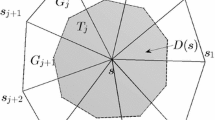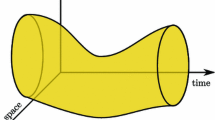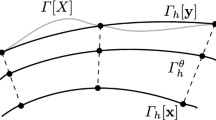Abstract
Numerical methods for approximating the solution of partial differential equations on evolving hypersurfaces using surface finite elements on evolving triangulated surfaces are presented. In the ALE ESFEM the vertices of the triangles evolve with a velocity which is normal to the hypersurface whilst having a tangential velocity which is arbitrary. This is in contrast to the original evolving surface finite element method in which the nodes move with a material velocity. Numerical experiments are presented which illustrate the value of choosing the arbitrary tangential velocity to improve mesh quality. Simulations of two applications arising in material science and biology are presented which couple the evolution of the surface to the solution of the surface partial differential equation.
Similar content being viewed by others
References
Adalsteinsson D ., Sethian J.A: Transport and diffusion of material quantities on propagating interfaces via level set methods. Journal of Computational Physics. 185, 271–288 (2003)
Barreira R, Elliott C, Madzvamuse A: The surface finite element method for pattern formation on evolving biological surfaces. Journal of Mathematical Biology. 63, 1095–1119 (2011)
J. W. Barrett and C. M. Elliott, A finite-element method for solving elliptic equations with Neumann data on a curved boundary using unfitted meshes, IMA Journal of Numerical Analysis, 4 (1984), pp. 309–325.
Barrett J. W., Garcke H., Nürnberg R.: On the variational approximation of combined second and fourth order geometric evolution equations. SIAM J. Sci. Comput., 29, 1006–1041 (2007)
J. W. Barrett, H. Garcke, and R. Nürnberg , A parametric finite element mthod for fourth order geometric evolution equations, J. Comp. Phys., 222 (2007), pp. 441–467.
J. W. Barrett, H. Garcke, and R. Nürnberg, Numerical approximation of anisotropic geometric evolution equations in the plane, IMA J. Numer. Anal., 28 (2008), pp. 292–330.
J. W. Barrett, H. Garcke, and R. Nürnberg, On the parametric finite element approximation of evolving hypersurfaces in R3, J. Comp. Phys., 227 (2008), pp. 4281–4307.
M. J. Berger, D. A. Calhoun, C. Helzel, and R. J. Leveque, adaptive refinement on the sphere logically rectangular finite volume methods with adaptive refinement on the sphere, Philosophical Transactions of the Royal Society of London A, 367 (2009), pp. 4483–4496.
M. Bertalmío, L.-T. Cheng, S. J. Osher, and G. Sapiro, Variational problems and partial differential equations on implicit surfaces, J. Comput. Phys., 174 (2001), pp. 759–780.
Cahn J.W., Fife P, Penrose O.: A phase-field model for diffusion-induced grain-boundary motion. Acta Materialia. 45, 4397–4413 (1997)
D. A. Calhoun and C. Helzel, A finite volume method for solving parabolic equations on logically cartesian curved surface meshes, SIAM J. Sci. Comput., 31 (2009), pp. 4066–4099.
M. A. J. Chaplain, M. Ganesh, and I. G. Graham, Spatio-temporal pattern formation on spherical surfaces: numerical simulation and application to solid tumour growth, Journal of Mathematical Biology, 42 (2001), pp. 387–423.
E. J. Crampin, E. A. Gaffney, and P. K. Maini, Reaction and diffusion on growing domains: Scenarios for robust pattern formation, Bull. Math. Biology, 61 (1999), pp. 1093–1120.
K. Deckelnick, G. Dziuk, and C. M. Elliott, Computation of geometric partial differential equations and mean curvature flow, Acta Numerica, 14 (2005), pp. 139–232.
K. Deckelnick, G. Dziuk, C. M. Elliott, and C.-J. Heine, An h-narrow band finite element method for implicit surfaces, IMA J. Numer. Anal., 30 (2010), pp. 351–376.
K. Deckelnick and C. Elliott, An existence and uniqueness result for a phase-field model of diffusion-induced grain-boundary motion, Proc. R. Soc. Edin., 131A (2001), pp. 1323–1344.
K. Deckelnick and C. M. Elliott, Finite element error bounds for curve shrinking with prescribed normal contact to a fixed boundary, IMA J. Numer. Anal., 18 (1998), pp. 635–654.
K. Deckelnick, C. M. Elliott, and V. Styles, Numerical diffusion-induced grain boundary motion, Interfaces and Free Boundaries, 6 (2001), pp. 329–349.
A. Dedner, P. Madhaven, and B. Stinner, Analysis of the discontinuous Galerkin method for elliptic problems on surfaces, IMA J. Numer. Anal., to appear (2012).
A. Demlow, Higher-order finite element methods and pointwise error estimates for elliptic problems on surfaces, SIAM J. Numer. Anal., 47 (2009), pp. 805–827.
Demlow , Dziuk G.: An adaptive finite element method for the Laplace- Beltrami operator on surfaces. SIAM Journal on Numerical Analysis. 45, 421–442 (2007)
G. Dziuk, Finite elements for the Beltrami operator on arbitrary surfaces, in Partial differential equations and calculus of variations, S. Hildebrandt and R. Leis, eds., vol. 1357 of Lecture Notes in Mathematics, Springer Berlin Heidelberg New York London Paris Tokyo, 1988, pp. 142–155.
G. Dziuk, An algorithm for evolutionary surfaces, Numerische Mathematik, 58 (1991), pp. 603–611.
G. Dziuk, Computational parametric Willmore flow, Numerische Mathematik, 111 (2008), pp. 55–80.
G. Dziuk and C. M. Elliott, Finite elements on evolving surfaces, IMA Journal Numerical Analysis, 25 (2007), pp. 385–407.
G. Dziuk and C. M. Elliott, Surface finite elements for parabolic equations, J. Comp. Mathematics, 25 (2007), pp. 385–407.
G. Dziuk and C. M. Elliott, Eulerian finite element method for parabolic pdes on implicit surfaces, Interfaces and Free Boundaries, 10 (2008), pp. 119–138.
G. Dziuk and C. M. Elliott, An Eulerian approach to transport and diffusion on evolving implicit surfaces, Computing and Visualization in Science, 13 (2010), pp. 17–28.
G. Dziuk and C. M. Elliott, Fully discrete evolving surface finite element method, SIAM J. Numer. Anal., to appear (2012).
G. Dziuk and C. M. Elliott, L 2 estimates for the evolving surface finite element method, Math. Comp., (2012).
G. Dziuk, C. Lubich, and D. Mansour, Runge-Kutta time discretization of parabolic differential equations on evolving surfaces, IMA Journal of Numerical Analysis, 32 (2012), pp. 394–416.
C. Eilks and C. M. Elliott, Numerical simulation of dealloying by surface dissolution via the evolving surface finite element method, Journal of Computational Physics, 227 (2008), pp. 9727–9741.
C. M. Elliott and T. Ranner, Finite element analysis for a coupled bulk-surface partial differential equation, IMA J. Numer. Anal., to appear (2012).
C. M. Elliott and B. Stinner, Analysis of a diffuse interface approach to an advection diffusion equation on a moving surfacei, Math. Mod. Meth. Appl. Sci., 5 (2009), pp. 787–802.
C. M. Elliott and B. Stinner, Modeling and computation of two phase geometric biomembranes using surface finite elements, J Comput Phys, 229 (2010), pp. 6585–6612.
C. M. Elliott, B. Stinner, V. Styles, and R. Welford, Numerical computation of advection and diffusion on evolving diffuse interfaces, IMA J. Numer. Anal., 31 (2011), pp. 786–812.
C. M. Elliott, B. Stinner, and C. Venkataraman, Modelling cell motility and chemotaxis with evolving surface finite elements, Journal of the Royal Society Interface, 9 (2012), pp. 3027–3044.
C. M. Elliott and V. Styles, Computations of bidirectional grain boundary dynamics in thin metallic films, Journal of Computational Physics, 187 (2003), pp. 524–543.
P. C. Fife, J. W. Cahn, and C. M. Elliott, A free-boundary model for diffusioninduced grain boundary motion, Interfaces Free Bound., 3 (2001), pp. 291–336.
P. C. Fife and X. Wang, Chemically induced grain boundary dynamics, forced motion by curvature, and the appearance of double seams, European J. Applied Mathematics, 13 (2002), pp. 25–52.
H. Garcke and V. M. Styles, Bi-directional diffusion induced grain boundary motion with triple junctions, Interfaces and Free Boundaries, 6 (2004), pp. 271–294.
Greer J. B.: An improvement of a recent Eulerian method for solving PDEs on general geometries. J. Sci. Comput. 29, 321–352 (2006)
J. B. Greer, A. L. Bertozzi, and G. Sapiro, Fourth order partial differential equations on general geometries, J. Comput. Phys., 216 (2006), pp. 216–246.
C. Handwerker, Diffusion-induced grain boundary migration in thin films, in Diffusion Phenomena in Thin Films and Microelectronic Materials, D. Gupta and P. Ho, eds., Noyes Pubs. Park Ridge, N.J., 1988, pp. 245–322.
A. Henderson, ParaView Guide, A Parallel Visualization Application, Kitware Inc., 2007.
A. J. James and J. Lowengrub, A surfactant-conserving volume-of-fluid method for interfacial flows with insoluble surfactant, Journal of Computational Physics, 201 (2004), pp. 685–722.
L. Ju and Q. Du, A finite volume method on general surfaces and its error estimates, J. Math. Anal. Appl., 352 (2009), pp. 645–668.
L. Ju, L. Tian, and D. Wang, A posteriori error estimates for finite volume approximations of elliptic equations on general surfaces, Comput. Methods Appl. Mech. Engrg., 198 (2009), pp. 716–726.
M. Lenz, S. F. Nemadjieu, and M. Rumpf, Finite volume method on moving surfaces v. Proceedings of the 5th international symposium held in Aussois, June 2008., in Finite volumes for complex applications, R.Eymard and J.-M. H´erard, eds., Hoboken, NJ,, 2008, John Wiley & Sons, Inc., pp. Hoboken, NJ,.
M. Lenz, S. F. Nemadjieu, and M. Rumpf, A convergent finite volume scheme for diffusion on evolving surfaces, SIAM J. Numer. Anal., 49 (2011), pp. 15–37.
C. B. Macdonald and S. J. Ruuth, Level set equations on surfaces via the Closest Point Method, Journal of Scientific Computing, 35 (2008), pp. 219–240.
C. B. Macdonald and S. J. Ruuth, The implicit closest point method for the numerical solution of partial differential equations on surfaces., SIAM J. Sci. Comput., 31 (2009), pp. 4330–4350.
U. F. Mayer and G. Simonett, Classical solutions for diffusion-induced grainboundary motion, J. Math. Anal. Appl., 234 (1999), pp. 660–674.
M. Neilson, J. Mackenzie, S. Webb, and R. Insall, Modelling cell movement and chemotaxis using pseudopod-based feedback, SIAM Journal on Scientific Computing, 33 (2011), pp. 1035–1057.
M. A. Olshanskii and A. Reusken, A finite element method for surface pdes: matrix properties, Numer. Math., 114 (2010), pp. 491–520.
M. A. Olshanskii, A. Reusken, and J. Grande, A finite element method for elliptic equations on surfaces, SIAM J. Numer. Anal., 47 (2009), pp. 3339–3358.
S. Osher and R. Fedkiw, Level set methods and dynamic implicit surfaces, vol. 153 of Appl. Math. Sci, Springer Verlag, 2003.
A. Ratz and A. Voigt, Pdes on surfaces - a diffuse interface approach, Communications in Mathematical Sciences, 4 (2006), pp. 575–590.
Ruuth S. J., Merriman B: A simple embedding method for solving partial differential equations on surfaces. Journal of Computational Physics. 227, 1943–1961 (2008)
A. Schmidt and K. G. Siebert, Design of adaptive finite element software: The finite element toolbox ALBERTA, vol. 42 of Lecture notes in computational science and engineering, Springer, 2005.
J. Schnakenberg, Simple chemical reaction systems with limit cycle behaviour, Journal of Theoretical Biology, 81 (1979), pp. 389–400.
J. A. Sethian, Level set methods and fast marching methods,, Cambridge Monographs on Applied and Computational Mathematics, Cambridge University Press, 1999.
J.-J. Xu and H.-K. Zhao, An Eulerian formulation for solving partial differential equations along a moving interface, Journal of Scientific Computing, 19 (2003), pp. 573–594.
Author information
Authors and Affiliations
Corresponding author
Additional information
The work of V. Styles was supported by the UK Engineering and Physical Sciences Research Council EPSRC Grant EP/D078334/1. The work of C. M. Elliott was supported by the UK Engineering and Physical Sciences Research Council EPSRC Grant EP/G010404.
Rights and permissions
About this article
Cite this article
Elliott, C.M., Styles, V. An ALE ESFEM for Solving PDEs on Evolving Surfaces. Milan J. Math. 80, 469–501 (2012). https://doi.org/10.1007/s00032-012-0195-6
Received:
Published:
Issue Date:
DOI: https://doi.org/10.1007/s00032-012-0195-6




